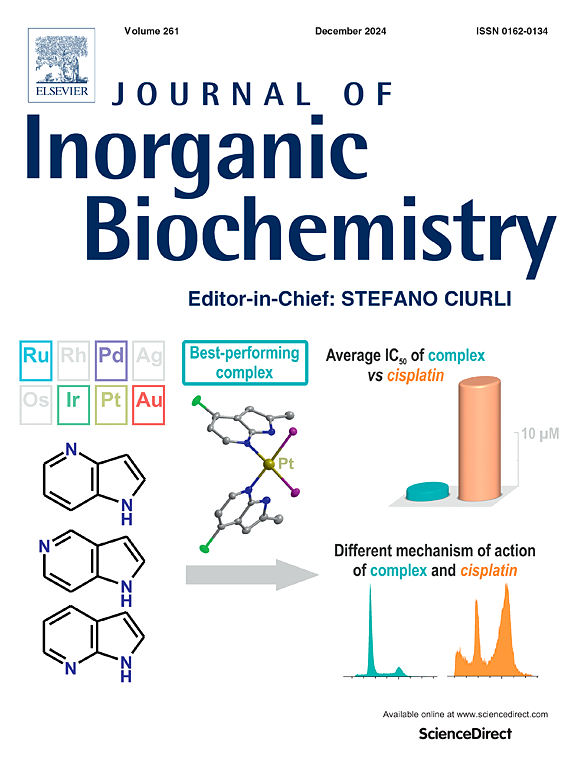镧系(III)依赖性甲醇脱氢酶辅助因子吡咯喹啉醌的水化反应
IF 3.8
2区 化学
Q2 BIOCHEMISTRY & MOLECULAR BIOLOGY
引用次数: 0
摘要
吡罗喹啉醌(PQQ)依赖的甲醇脱氢酶(MDH)在其活性位点携带Ca2+或镧系(Ln3+)离子氧化甲醇的机制一直备受争议。特别是,Ln-MDH的Ln3+依赖性活性仍然知之甚少。缺乏实验证据是提高我们对这些酶的理解的一个重大限制。在这项工作中,我们提出可以通过检查PQQ的水化反应模型来获得对Ca-和Ln-MDH反应性的见解。事实上,这一反应类似于假定的甲醇加减机制的第一步,并且预计同样会受到金属离子的影响。采用紫外吸收光谱法测定了PQQ对Ca2+和Ln3+的表观亲和常数。采用稳态荧光光谱法和时间分辨荧光光谱法对水溶液中的Ln-PQQ配合物进行了分析。通过变温和质子交换光谱(EXSY) NMR以及DFT计算得到了描述平衡的热力学和动力学参数。结果表明,交换速率对PQQ水合平衡具有一定的依赖关系,较晚且Lewis酸性较强的Ln3+对PQQ水合平衡的影响较大。本文章由计算机程序翻译,如有差异,请以英文原文为准。

Lanthanide(III)-dependent hydration of the methanol dehydrogenase cofactor, pyrroloquinoline quinone
The mechanism by which pyrroloquinoline quinone (PQQ)-dependent methanol dehydrogenases (MDH), bearing either a Ca2+ or a lanthanide (Ln3+) ion in their active site, oxidize methanol has been intensely debated. In particular, the Ln3+-dependent activity of Ln-MDH remains poorly understood. The lack of experimental evidence represents a significant limitation to improve our understanding of these enzymes. In this work, we propose that insights on Ca- and Ln-MDH reactivity can be gained by examining a model reaction, the hydration of PQQ. Indeed, this reaction is similar to the first step of the putative methanol addition-elimination mechanism and is expected to be similarly influenced by the metal ion. The apparent affinity constants of PQQ for Ca2+ and Ln3+ were determined by UVvis absorption spectroscopy. Ln-PQQ complexes in aqueous solution were analyzed by steady-state and time-resolved fluorescence spectroscopy. The thermodynamic and kinetic parameters describing the equilibrium were obtained by variable-temperature and proton exchange spectroscopy (EXSY) NMR, as well as DFT calculations. Results demonstrated a Ln-dependent exchange rate for PQQ hydration equilibrium, the late and more Lewis acidic Ln3+ having the stronger impact.
求助全文
通过发布文献求助,成功后即可免费获取论文全文。
去求助
来源期刊

Journal of Inorganic Biochemistry
生物-生化与分子生物学
CiteScore
7.00
自引率
10.30%
发文量
336
审稿时长
41 days
期刊介绍:
The Journal of Inorganic Biochemistry is an established international forum for research in all aspects of Biological Inorganic Chemistry. Original papers of a high scientific level are published in the form of Articles (full length papers), Short Communications, Focused Reviews and Bioinorganic Methods. Topics include: the chemistry, structure and function of metalloenzymes; the interaction of inorganic ions and molecules with proteins and nucleic acids; the synthesis and properties of coordination complexes of biological interest including both structural and functional model systems; the function of metal- containing systems in the regulation of gene expression; the role of metals in medicine; the application of spectroscopic methods to determine the structure of metallobiomolecules; the preparation and characterization of metal-based biomaterials; and related systems. The emphasis of the Journal is on the structure and mechanism of action of metallobiomolecules.
 求助内容:
求助内容: 应助结果提醒方式:
应助结果提醒方式:


